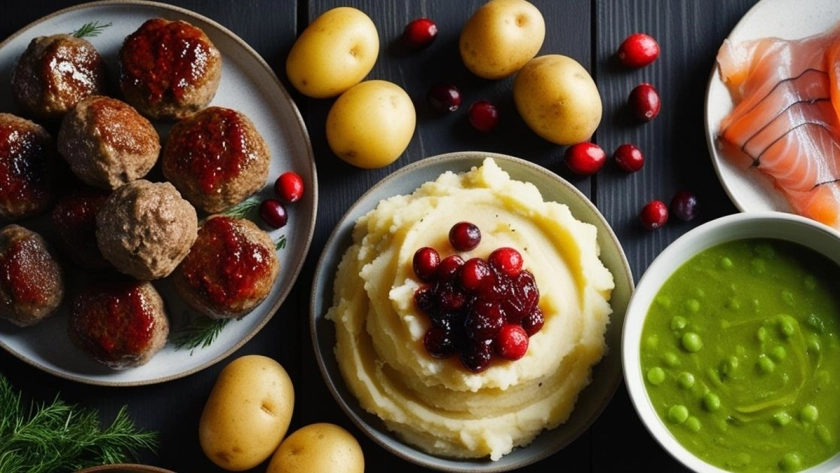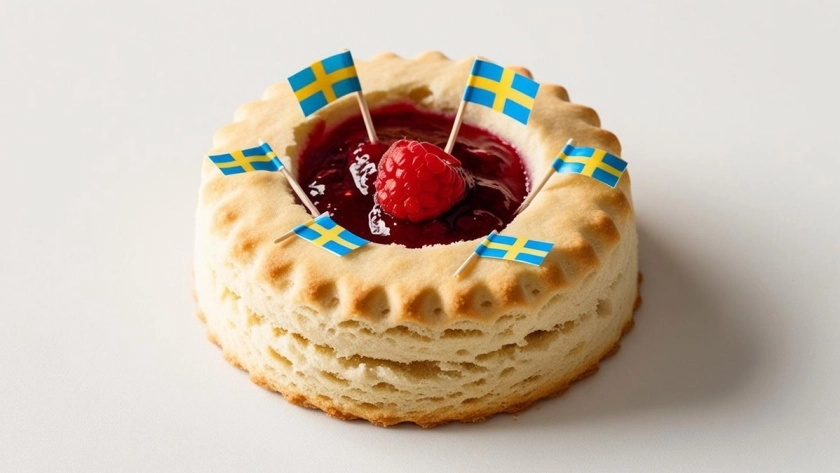
Husmanskost (where Husman means "farmer" and kost comes from the Old Swedish kostr, meaning sustenance or provision) is a Swedish term referring to traditional Swedish cuisine, often called "home cooking" or "regional cuisine" in French. It consists of simple, rustic, and nourishing dishes that were historically prepared by rural families to feed workers with locally sourced, inexpensive ingredients. This cuisine highlights authentic flavors and typical Swedish local products, such as potatoes, fish, meat (particularly pork and beef), as well as seasonal vegetables and grains. Today, this type of cooking is appreciated for its simplicity and nutritional value, but also for its nostalgic character (a kind of madeleine de Proust for Swedes). Many chefs in Sweden reinterpret traditional Husmanskost dishes, modernizing them or presenting them in creative ways while still respecting their rural culinary roots.
A bit of history...
The history of this cuisine is deeply tied to the evolution of Swedish society and its agricultural roots. In Sweden, as in many Nordic countries, the harsh climate greatly limited farming possibilities; cuisine was largely shaped by these very limited resources. The long winters and lack of variety in fresh produce required dishes that used ingredients that could be easily preserved, such as potatoes, cabbage, salted meats, and freshwater fish.

Farmers also had to live autonomously and survive thanks to the resources from their land and local environment during long periods of isolation. Preservation techniques (such as salting, smoking, and fermenting) and the reuse of leftovers (a good example being pytt i panna) are an integral part of the history of husmanskost. These practical needs and this traditional way of life shaped the cuisine, as they also provided an effective solution for feeding all the people working on the farm during the long winter months.
With the industrial revolution and urbanization in the 19th century, many Swedes left the countryside for the cities but maintained their habits in these new urban settings. Husmanskost then became a term used to distinguish the simple everyday dishes from more refined cuisine inspired by international trends. After World War II, foreign cuisines (especially Italian and American) began to dominate, while husmanskost lost some of its prominence in everyday eating habits, becoming perceived as outdated or reserved for older generations.
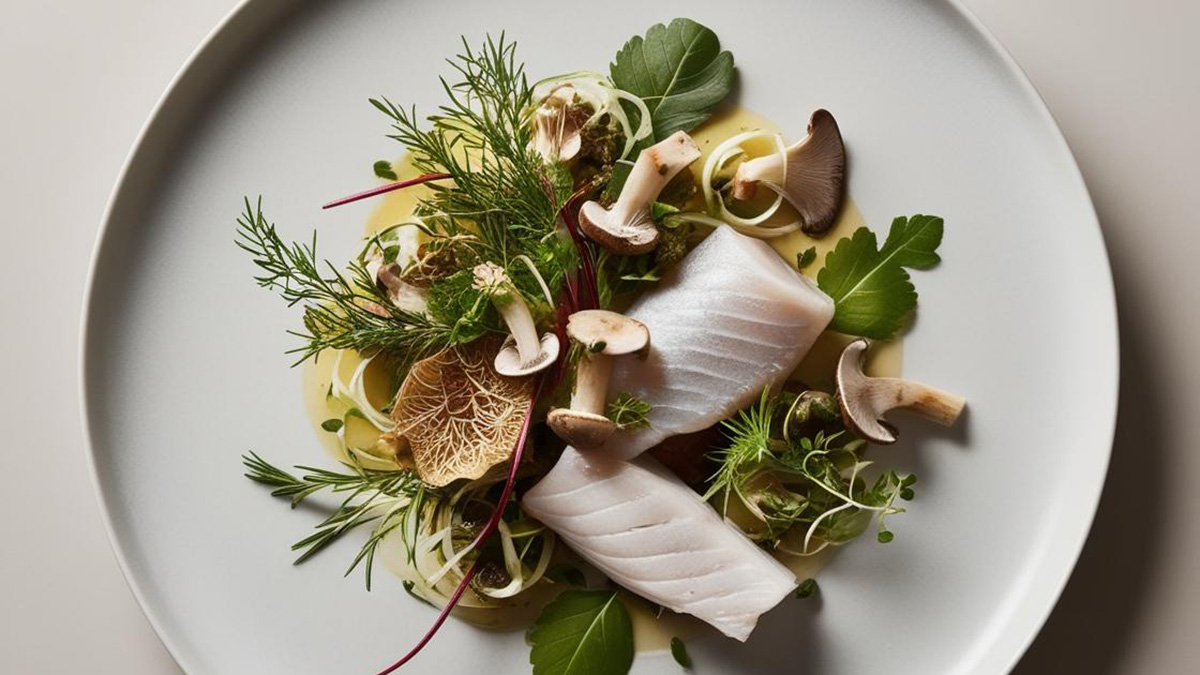
At the end of the 1990s, thanks in particular to the movement called "New Nordic Cuisine," there was a resurgence of interest in local culinary traditions. This culinary movement highlights the local, seasonal, and wild ingredients of the Nordic countries, reinventing traditional dishes with modern techniques (fermentation, dehydration, etc.). This cuisine is characterized by its simplicity, respect for nature, and commitment to sustainability, while also exploring unique and bold flavors. Today, Sweden’s top chefs are modernizing recipes and focusing on high-quality ingredients, often organic or local. Today, in general, husmanskost remains appreciated in Swedish households and during traditional celebrations, such as julbord (the Swedish Christmas feast) or Midsommar (Midsummer festival). Dishes from the husmanskost tradition are also often featured in krogar (taverns or small traditional restaurants), where Swedes and visitors alike can discover Swedish traditional cuisine.
The main criteria of husmanskost
So, what defines husmanskost? Are there specific criteria to deserve this unregulated designation (-Controlled Designation of Origin - AOCs don’t formally exist in Sweden, European quality labels like IGP or STG are used)?
If we had to establish 5 main characteristics of husmanskost, they would probably be:
- Simplicity and rusticity : husmanskost cuisine is, by nature, simple and rustic. Dishes are typically not elaborate and require easily accessible and inexpensive ingredients, but they are rich in flavor. The focus is on simple cooking techniques such as frying, boiling, steaming, and using fresh or local products.
- Use of local and seasonal ingredients : husmanskost traditionally relies on products found in Swedish nature or on local farms. These are sustainable ingredients like potatoes, root vegetables (carrots, beets, cabbage), meats (often pork or cattle), freshwater fish, as well as fermented or salted products.
- Easily preservable products : due to Sweden’s harsh climate, husmanskost dishes were often designed to maximize food preservation. Techniques like fermentation (for example, surströmming, fermented herring), salting, smoking, and canning were common. The use of ingredients like cabbage or potatoes, which can be stored through the winter months, is also typical.
- Nourishing and comforting dishes : husmanskost cuisine is first and foremost nourishing and comforting. Dishes are designed to satisfy significant hunger and provide energy, especially in a climate where winters are long and harsh. These dishes are often hearty, with generous portions of meat, potatoes, and vegetables.
- Tradition and a sense of belonging : beyond the concept of comfort, which is very important, husmanskost is also a tradition passed down from generation to generation. It embodies a deep and lasting sense of belonging to Swedish culture, being both a link to the country’s historical past, a reflection of simplicity and authenticity, a means of preserving traditions, and a symbol of social equality.
This cuisine is more than just an act of feeding the body: it also nourishes the soul, strengthens community and family bonds, and celebrates a national identity marked by a connection to nature, seasonality, and resilience.
6 iconic Husmanskost dishes
1. Köttbullar med potatismos
The famous Swedish meatballs served with potatoes or mashed potatoes (there are a couple of variations on this) and often accompanied by lingonberry jam or fresh berries, pickled cucumbers (in a mixture of vinegar and sugar), and a brown sauce, which chefs often consider a bit of a secret and personal recipe.
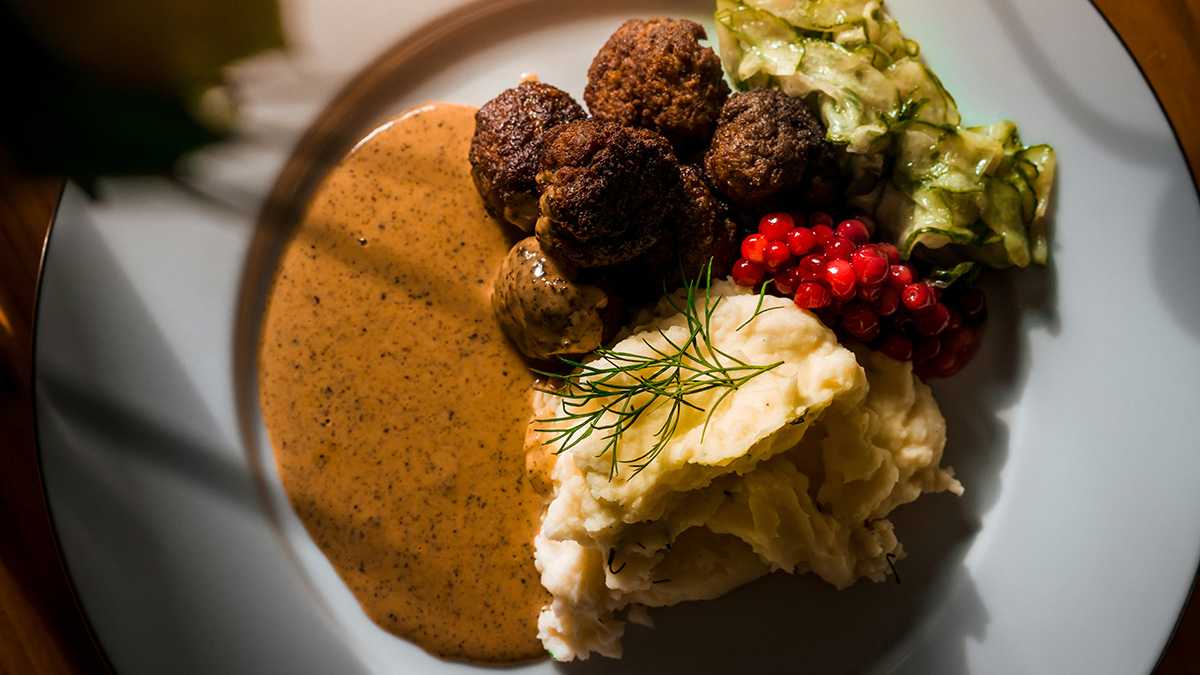
Köttbullar (meatballs) are, of course, an iconic dish in Swedish cuisine, recognized worldwide as a symbol of traditional Swedish gastronomy. They are typically made with a mixture of pork and beef (to prevent them from becoming too dry), but one can also use other meats such as reindeer or moose, lamb, and there are even vegetarian versions, as equality is a very important principle in Swedish culture. Köttbullar are also a comforting dish, symbolizing conviviality and sharing, often served during large family gatherings or parties. They are an expression of Swedish cuisine in its most authentic form: simple, nourishing, and full of flavor.
2. Raggmunk
These are potato pancakes or fritters made from grated potatoes (somewhat similar to Swiss rösti), and they are generally served with smoked bacon and lingonberry jam or fresh lingonberries.

Credits : Magnus Carlsson/imagebank.sweden.se
Raggmunk is another iconic dish in Swedish cuisine, particularly appreciated for its simplicity and comforting nature. It consists of grated potato patties, similar to råraka, but with an important difference: raggmunk is made with a batter, often consisting of eggs, flour, and milk, which gives it a slightly lighter and airier texture compared to råraka (which are crispier and made with raw potatoes).
Like many other Swedish potato-based dishes, raggmunk is often served with sour cream (gräddfil) and lingonberries, a typical accompaniment for many Swedish dishes. The lingonberries add a sweet-and-tart touch that contrasts with the richness of the potatoes and sour cream, creating a balanced flavor profile that is highly appreciated in Swedish cuisine.
3. Pytt i panna
This is a hash made from potatoes, meat (often leftovers), and onions, typically served with a fried egg and pickled beetroot. Pytt i panna is essentially a leftover mix, traditionally made with sautéed potatoes, ground meat (usually beef or pork), and sometimes other ingredients like onions, vegetables, or sausages. It is a dish born from the need to reuse leftovers to avoid waste, a value that resonates deeply in Swedish culture. This practical and economical dish has become a favorite in Swedish households, especially after hearty meals or during times when food resources are limited.
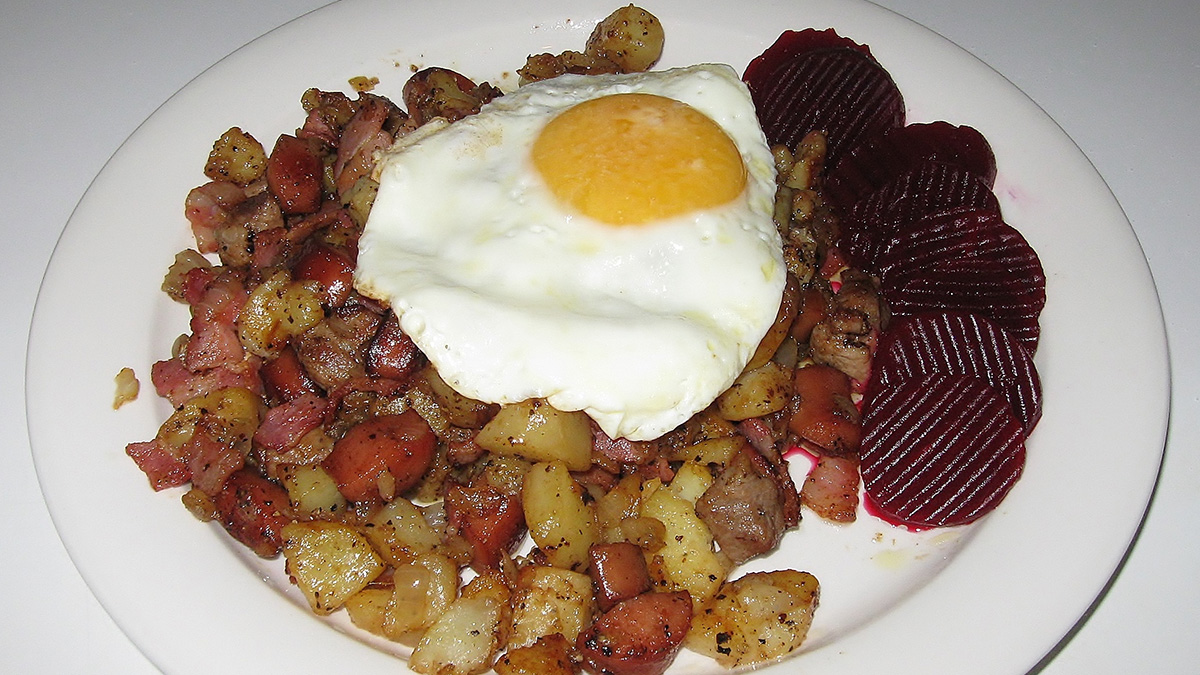
Although it is a simple dish, pytt i panna also has a social and convivial dimension. It is often served with a fried egg on top and sometimes accompanied by pickles or pickled vegetables, which add a touch of freshness and acidity to balance the richness of the dish. The combination of these elements creates a comforting meal, ideal for a family dinner or gathering with friends. Furthermore, pytt i panna can also be prepared in large quantities, making it a perfect dish for shared meals. Its informal and relaxed nature makes it a favorite during social occasions, typically at the weekend or after a night out.
4. Gravad lax
This is dry-cured salmon, prepared with a combination of salt, sugar, and dill, and it is a true symbol of Swedish culinary identity. Gravad lax has a rich history and holds an important place in Swedish culture and food rituals. The word "gravad" means "buried" in Swedish, as originally, this dish was prepared in a very different way: the fish was buried in the ground to naturally marinate in the earth. This process allowed the salmon to be preserved before refrigeration was available. However, today, the method has evolved, and gravad lax is made by dry-curing the fish, covering it with a mixture of salt, sugar, and spices, without burying it.
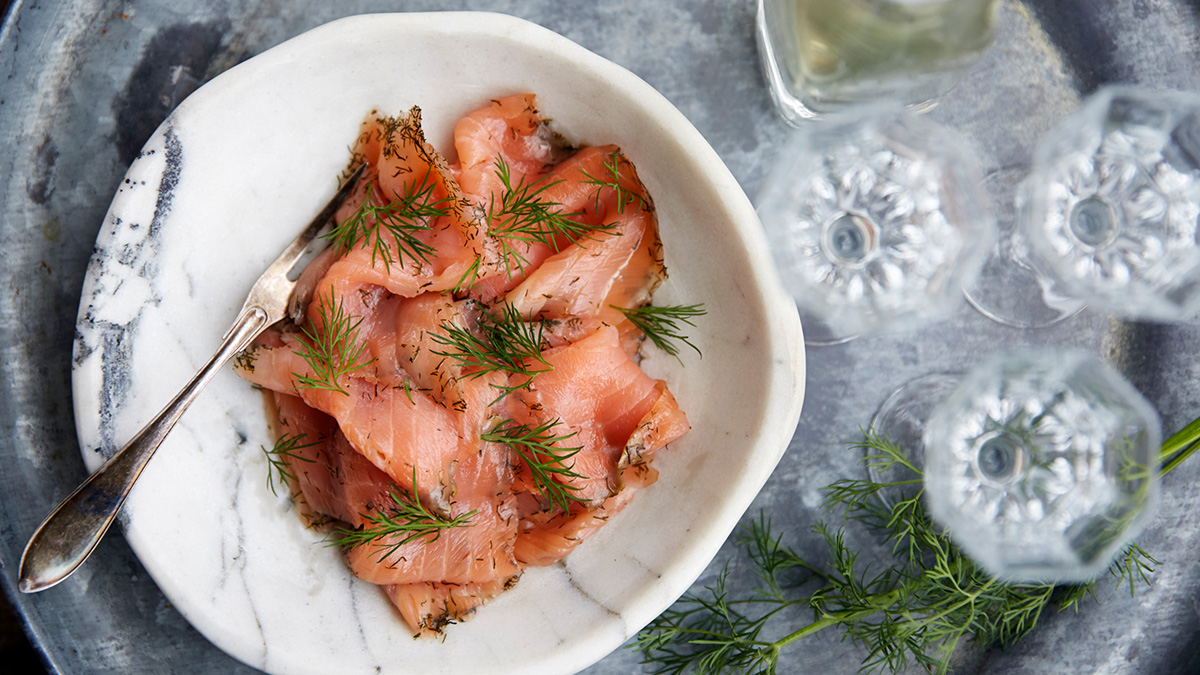
Credits: Magnus Carlsson/imagebank.sweden.se
The preparation of gravad lax is relatively simple, but it requires some patience. Fresh salmon is first covered with a mix of salt, sugar, and dill. Sometimes, spices like peppercorns or citrus zest are added to customize the flavor. The fish is then left to marinate in the refrigerator for 24 to 48 hours, the time needed for the salt and sugar to penetrate the salmon's flesh and infuse it with flavor.
Once marinated, gravad lax is sliced thinly and is typically served with accompaniments such as sweet mustard (the famous senapssås), rye bread, or new potatoes.
4. Sill och potatis
Pickled herring served with new potatoes, often accompanied by onions, sour cream, and herbs. This dish is another classic of Swedish cuisine, particularly popular during traditional holidays such as Midsommar (the summer solstice celebration), Julbord (the Swedish Christmas feast), and even during daily meals in some homes. This simple yet symbolic dish reflects both the culinary traditions and cultural values of Sweden
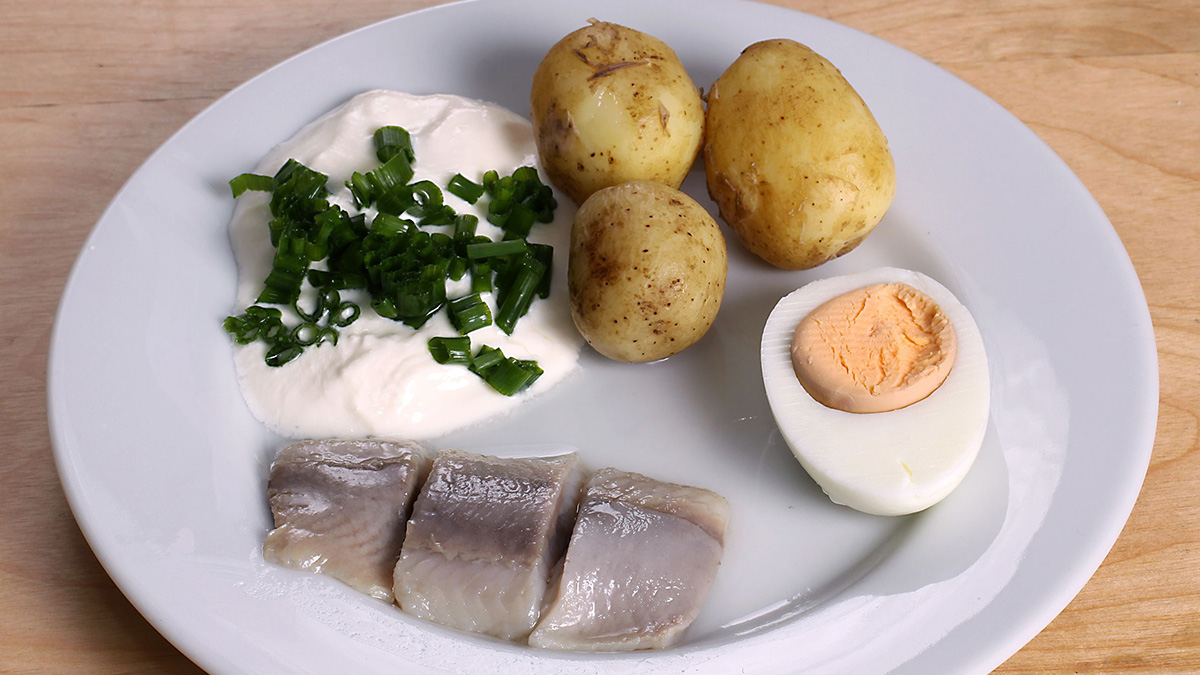
Sill och potatis is a dish made with pickled herring served with boiled new potatoes. Herring, a fish commonly found in the cold waters of the Baltic Sea and the North Sea, has been a staple of Swedish daily meals for centuries, especially in coastal regions. The dish combines pickled herring (sill), often marinated in vinegar or sugar-based solutions, with potatoes, creating a combination of salty and fresh flavors.
Herring is prepared in many different ways in Sweden, and there are numerous variations of the marinade, ranging from acidic (vinegar) to sweet (sugar and spices), with more creative versions including herbs or spices such as pepper, bay leaves, or even ginger.
6. Ärtsoppa och pannkakor
Yellow split pea soup (not chickpeas) is a comforting dish, especially in winter, and is often served on Thursdays in many homes and canteens in Sweden. It is typically followed by pancakes (crêpes) for dessert, making it a complete and nutritious meal. But more importantly, as everyone knows, to get children to eat soup, a little "compensation" in the form of a sweet dessert is often needed!
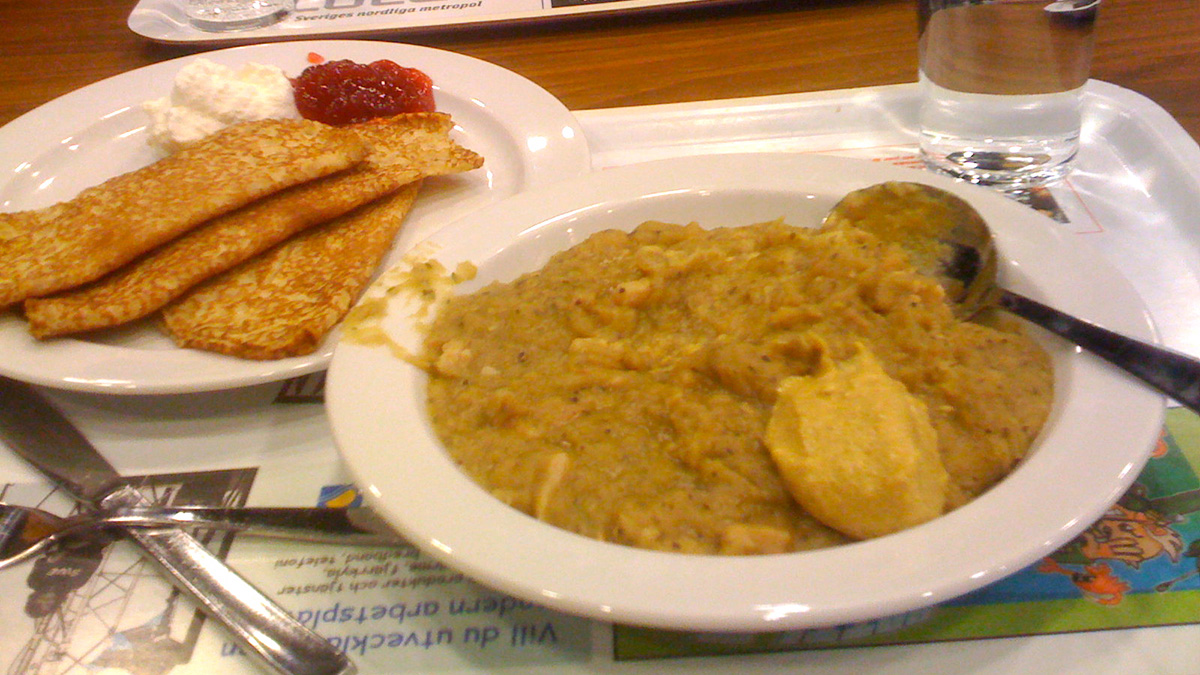
This soup embodies the simplicity and pragmatism of Swedish cuisine. It is an inexpensive dish, easy to prepare with basic ingredients, yet flavorful and nutritious. Although ärtsoppa is mainly associated with everyday meals, it also has a festive dimension. For example, during the celebrations of Shrove Tuesday (before Lent), it is traditional to consume this soup in large quantities, marking a final winter meal before the dietary restrictions of spring. And husmanskost includes many other recipes...
 en
en FR
FR IT
IT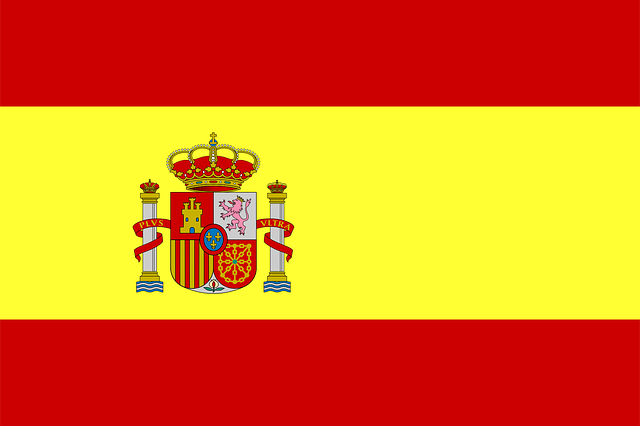 ES
ES
